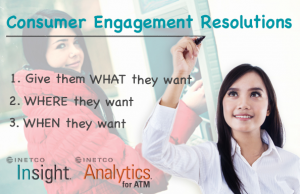Leading banks and credit unions are evolving their self-service strategies to focus more on consumer engagement. While proper placement and availability remain cornerstones of an effective self-service program, understanding how, when and where consumers use these channels is the next step to growing usage and profitability.

However, many institutions lack ready insight into how consumers use self-service channels, where they transact, and what can be done to improve engagement. This is because very few self-service strategies include a consistent analysis of consumer transactions – the ultimate big data…
And yet, understanding transactions can tell us all sorts of interesting things about our self-service environment and how effective our strategy is. Here are some examples:
- Which locations are most popular with off us consumers?
- Where are consumers routinely waiting in line at my ATMs?
- Which transaction sequences should I look to accelerate through screen flow redesign or hardware upgrades like envelope-less deposit?
- Which consumers are using mobile and the ATM channel and what do they use each for?
- Which locations should I target for assisted service rollout, based on the complexity of consumer transactions at the ATM and branch interactions?
Clearly, harnessing your transaction data can help your drive your self-service strategy forward. There are a number of approaches to capturing transaction data and making sense of it, but most of these have severe limitations, especially when it comes to scaling across channels.
To learn more about various approaches, you can access our on-demand webinar: Meeting Your Top 3 Consumer Engagement Resolutions.


 English
English French
French Portuguese
Portuguese Spanish
Spanish